Top 5 reasons to build your personal brand on LinkedIn in 2025




Personal branding is probably a term you have increasingly heard more of on LinkedIn. So what does personal branding actually mean?
In this blog, we're going to introduce personal branding and give you 5 reasons why it is important. We'll be doing this by sharing anecdotes from the SHIELD team, LinkedIn influencers, and creators on the platform.
What is personal branding?
To put it simply. Personal branding is your reputation. So if you are taking the time to intentionally work on how others perceive you, you are essentially working on your personal brand!
For example, maybe you've written blogs or articles on the latest developments and technologies in your industry. You would begin to build a reputation as a thought-leader. When you write and publish publicly and do it consistently people begin to perceive you as someone who is an expert and a thought leader. Now that's you building your personal brand. Something recognisable and familiar.
So why should you consider building your reputation on LinkedIn? What unique benefits can strong personal branding on LinkedIn give you compared to other platforms?
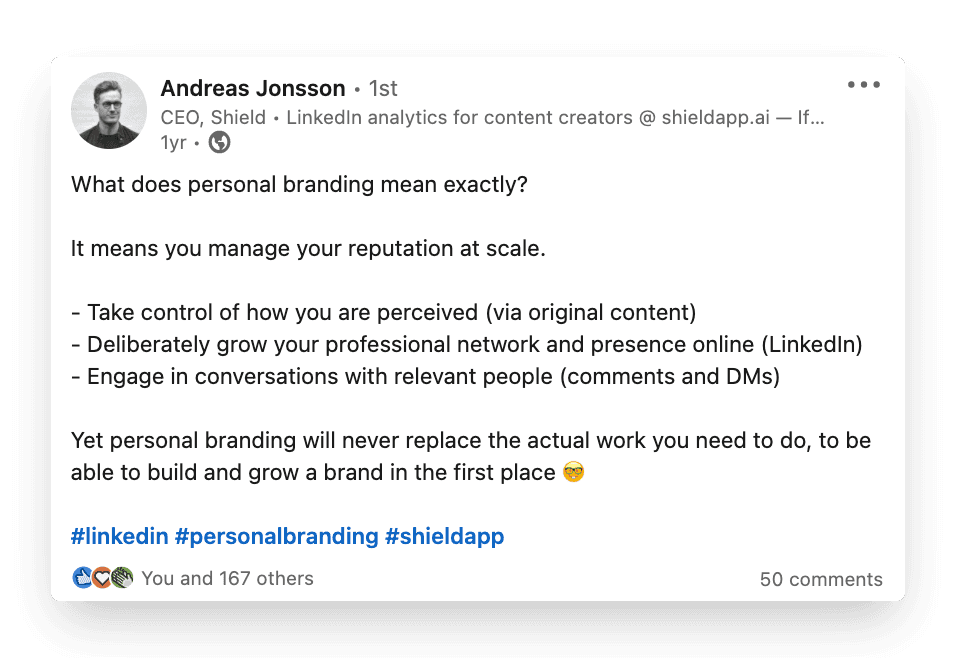
These are all questions we will answer in this blog.
There are many reasons why the popularity of personal branding has shot up in recent times. One of the main reasons are employment and career growth. And for those looking to start their own thing, this is the best way to build credibility in the market.
In an employment scene more competitive than ever, you need to stand out amongst the competition and be a no-brainer option for the hirer.
Other reasons include generating a sense of expertise, and for users to more efficiently grow their networks.
In this blog, we're going to take a look at 5 top reasons why personal branding on LinkedIn is important.
If you invest time and build your personal brand, you are taking control of your reputation in your hands. Within the first few months of consistently creating content, you will notice benefits flowing in. The top 5 benefits you will see ↓
Take control of your reputation
Get your dream job
Make a fantastic first impression
Build an engaged audience
Humanize your organization
Here we go!
1. Take control of your reputation
"The only way to treat a LinkedIn profile is like a website's landing page."
Your personal brand is akin to a landing page. Let me explain how → A website's landing page gives a user the first impression of the company and its products.
When a user enters a landing page, they are looking and scanning different elements. This helps them come to a number of decisions. These could be:
Do I trust this company? Do they provide what I need? Do I like them? Is it easy to use? Do others trust them?
This is a non-exhaustive list, but ultimately these decisions lead a website visitor to buy the services of a company or not. If they like the page, they may stay, consume content and get in touch. If they don't like the page, they may leave and business is lost.
Think of personal branding as your landing page for your reputation. When someone visits your profile for the first time they will look at what you talk about and try to gauge your knowledge. Can they trust your judgement? Are you an expert? Are you professional? Are you consistent?
With no personal branding, one might find it hard to answer these questions and may go elsewhere for their insight.
Therefore, it is critical you have your profile optimized so you can guide your profile visitors to the right content. When you create content on LinkedIn, you control the narrative. You control your own story and you decide what others think of you.
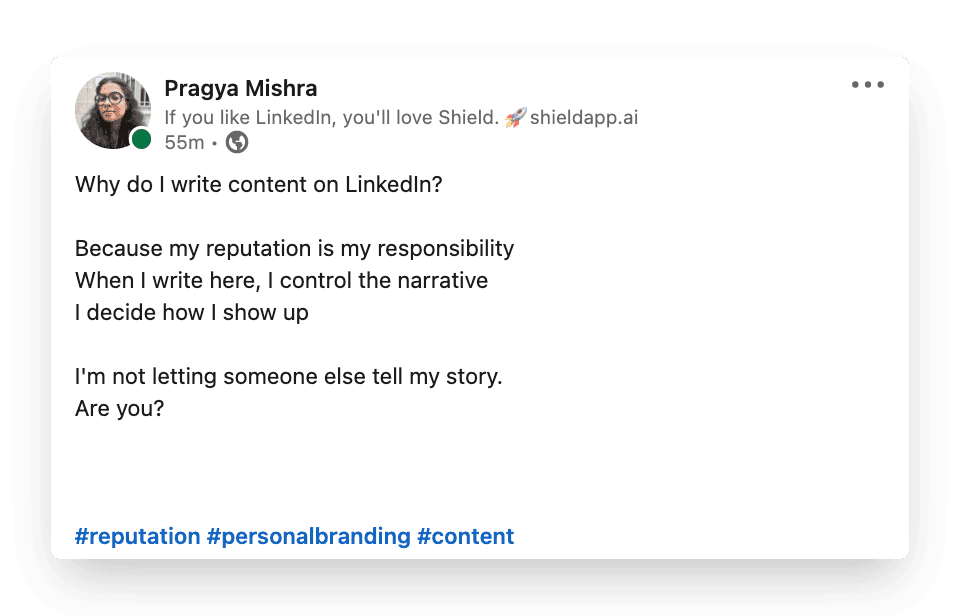
Maybe you're using LinkedIn for finding your next career move establishing thought-leadership, or to simply to grow your network and connect with others. Whatever your use, personal branding is a great vehicle. To get a head start on enhancing your reputation, start by optimising your profile and getting into a consistent posting routine.
You don't have to do this all in one go. Start out small and build out step by step. Don't worry about getting brand colours, tones or tag lines. This happens over time. So don't get put off by larger creators or influencers with finished products. Remember, they started out just like you! You're most likely seeing the 10th, 20th or beyond iteration of their profile. Don't let it stop you from exploring the wonders of personal branding yourself.
We all already have a personal brand. This is because you already have a reputation and will come to mind for people for certain things. Maybe one of your friends needs advice about social media marketing, and you're the first one to pop in their head.
Personal branding will take this a step further. It takes control of the reputation others have of you and turns it into your very own brand. And it expands your circle beyond the people you know around you at work.
"That's the beauty of LinkedIn. You have the opportunity to build relationships with people around the globe."
By delivering consistent high-quality content, your audience will end up expecting a high level of insight for you. This can help transform you into a thought-leader in your field. Being consistent is critical across all your personal branding. Let's take colours for example. By being consistent over a number of decades some businesses are recognisable on their brand colours alone. Take a look at the colours below. What brand do you think of?
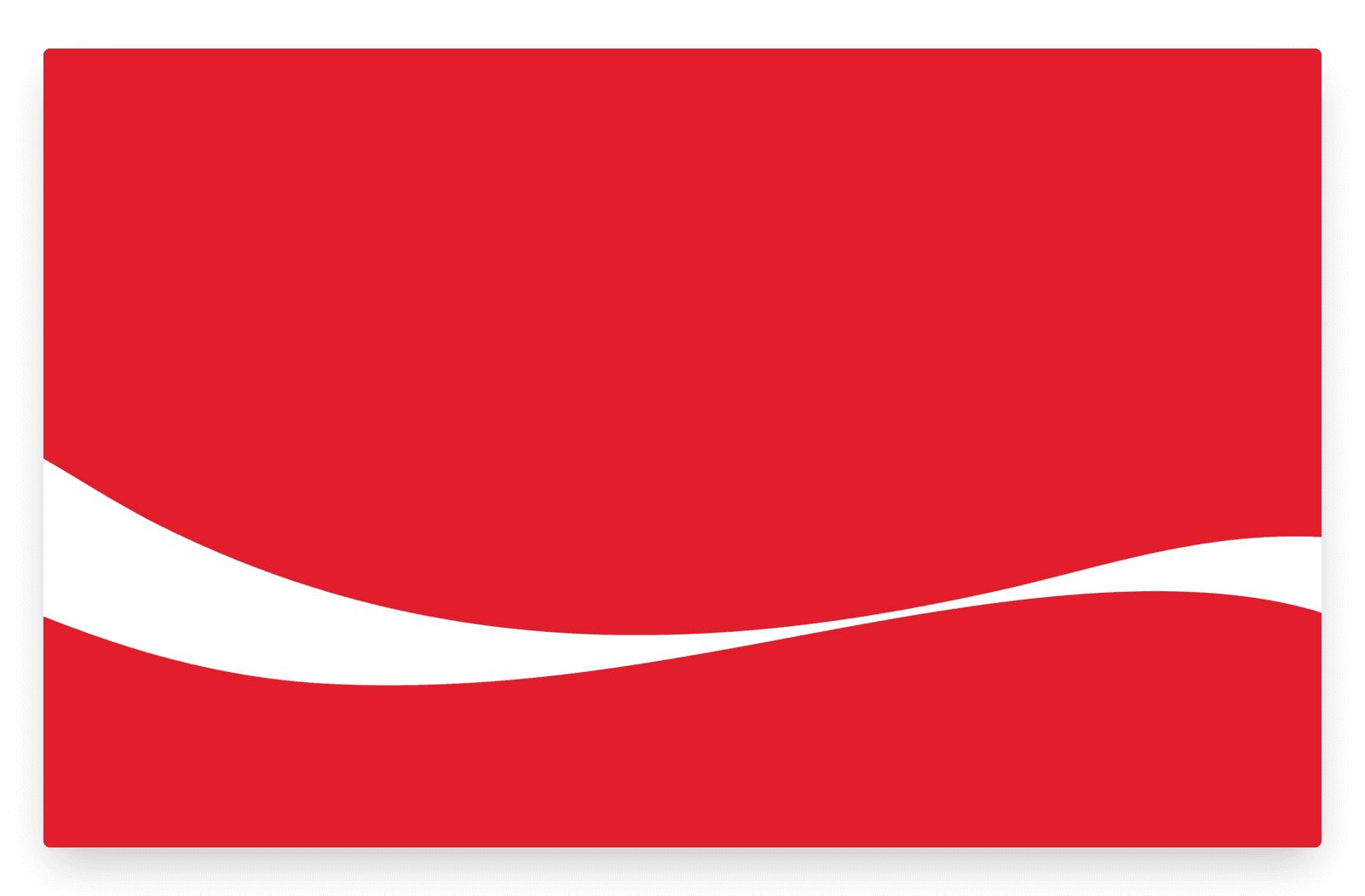
Did you guess Coca Cola? If so you're right!
In fact, Coca Cola's colour branding has been so successful, they even have the rights to the colour. It's called "Coke Red". This way, they ensure they're the only company in the world to use this exact colour, and when people see it they immediately think of Coca Cola and all the emotions that come with it. Good marketing!
But what about people? Are colours making their mark here too?
Let's look at some examples!
Take this example from Amelia Sordell's profile. By using strong brand colours (purple + pink), Amelia is able to make her content and profile stand out with ease. After consuming her content multiple times, her audience will be able to easily recognise a post is from her just by seeing the brand colours. If they trust and think Amelia has a high level of expertise, the post will evoke these emotions too.

Here's another great example from Will Allred.
You can see how the purple from Lavender translates nicely across the header image and profile picture. When users land on Will's page they will quickly realise he is professional and knows a lot about email! Bonus kudos to Will for branding himself as "the email guy"!
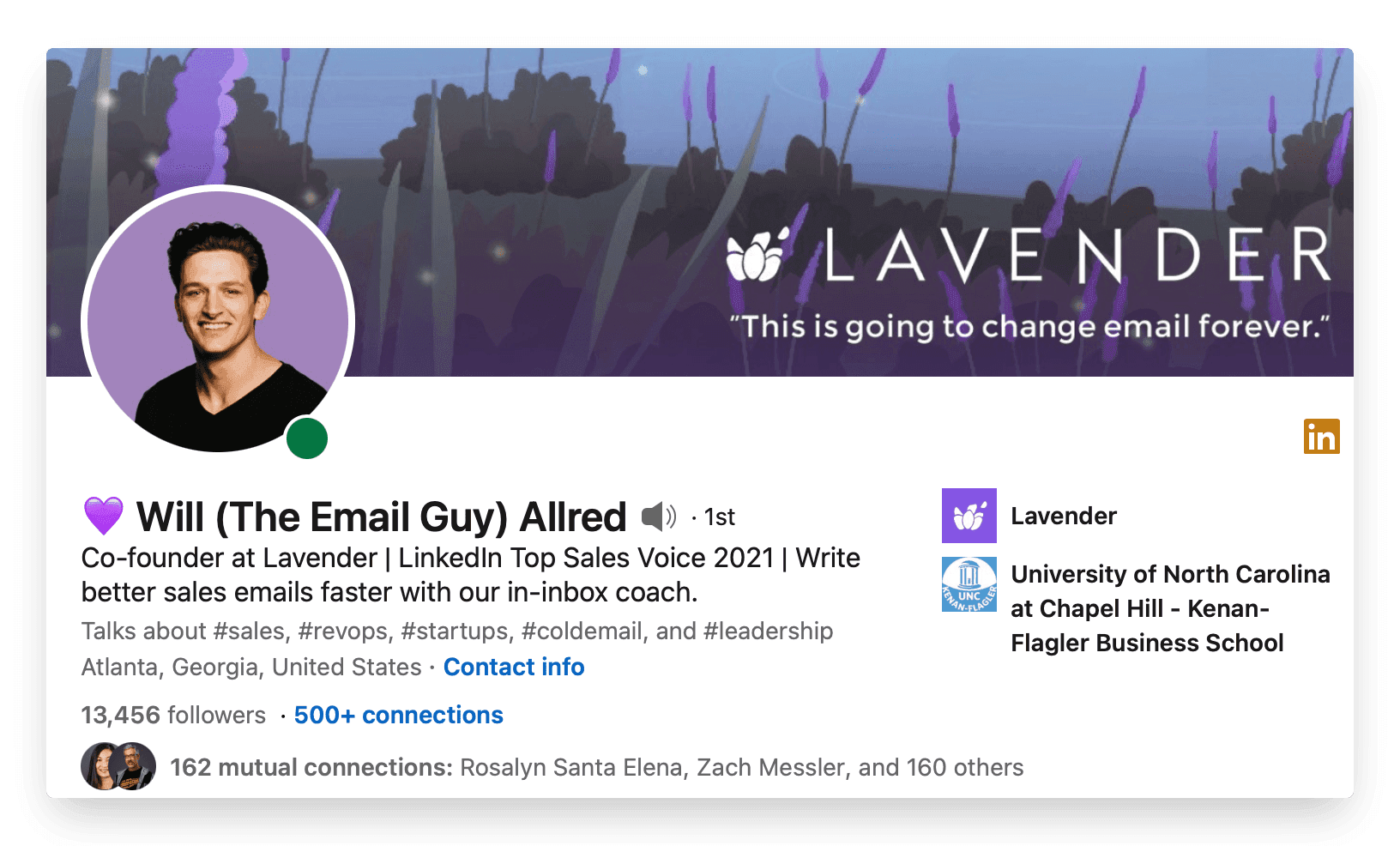
When you build a personal brand with intention you stay top-of-mind for others to go to. Whether it's for employment, advice, leadership, or expertise, if you are known for a particular thing, others will think of you when they think of that particular thing. For example, with Will Allred, when people think about needing help optimising their email, Will might be the first person to come to mind. This will have positive ramifications on his company and his audience growth.
The great thing about personal branding is that your content is doing the work for you. Instead of literally saying "I am the best content marketer on the planet", you show off your expertise through insightful posts, and great content marketing on your profile. When people visit your profile they can tell you're a good content marketer just from the content you post.
2. Get your dream job
The competition in the job market is more fierce than ever. This has especially been the case since the sharp uptick in remote working. This means the job candidate pool no longer resides in a strict geographical boundary. Now, people are able to apply for most jobs from anywhere in the world. For this reason, it's become more important than ever to ensure you stand out amongst the competition and make yourself a no-brainer for any employer.
By optimising your personal brand and positioning yourself as an expert in your field, you can gain a huge advantage in the employment market. Putting some effort and consideration into your personal brand will take you far.
When you consistently create and publish great content, your audience will be playing close attention. They could be CEOs, business owners, managers, or employers. These are all people who could be looking for potential hires. Creating content on LinkedIn has this very unique benefit in comparison to other platforms. A real example from our team is how Pragya got hired!
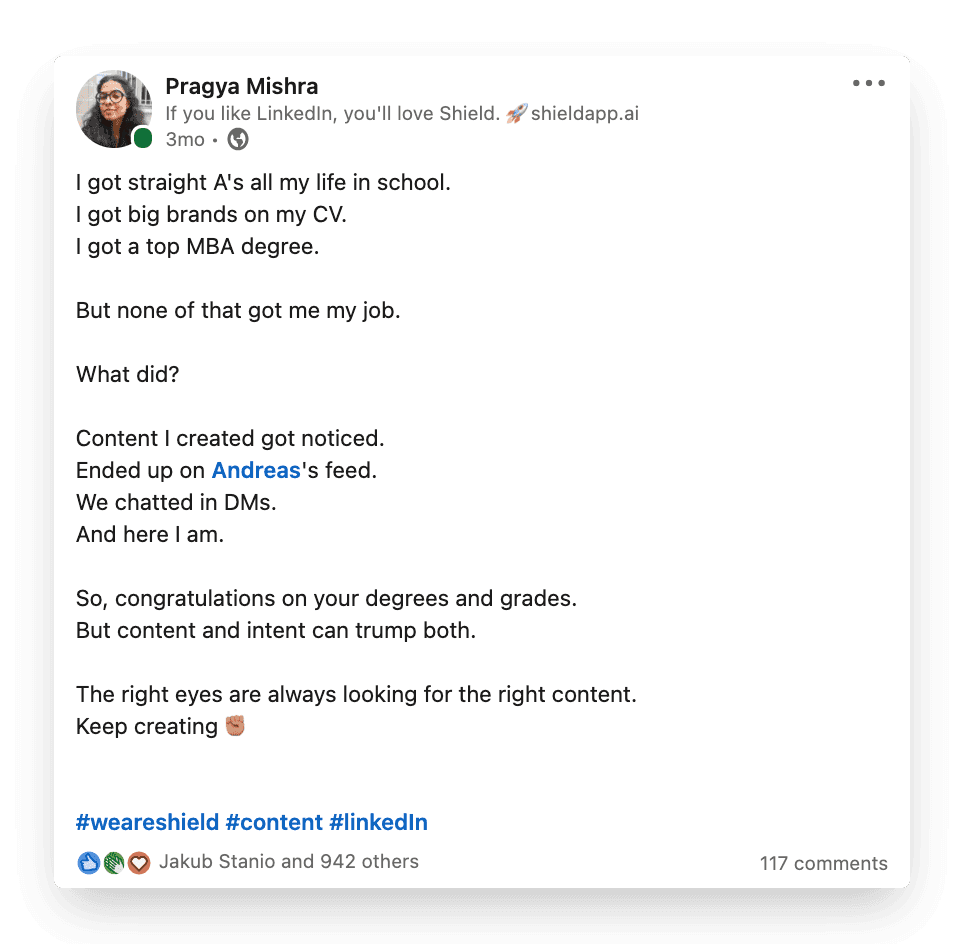
The opportunities for employment on LinkedIn are huge and there's so much you can do to benefit your own employment journey. As your audience's trust grows in you and you become an expert in your field, you are more likely to attract employers.
A powerful personal brand flips the script from you looking for a job to jobs looking for you. When your content shows up consistently in the feed of hiring mangers, you stay top of mind when there is a position open. And your personal brand acts like your dynamic digital CV, constantly evolving and bringing new people to your network. Follow this simple list from Filippo to use LinkedIn content creation to land yourself your dream job.

3. Make a fantastic first impression
First impressions are everything... Walking into a shop, a job, a potential partner, getting into a new car, or clicking on a LinkedIn profile, these first impressions matter.
The first time you see a LinkedIn profile, you start to form opinions on the owner of the profile. You will think are they an expert? Are they trustworthy? Do they post often? Are they professional? All these questions will lead to an ultimate decision on whether to click the follow button or not.
Coming across a nice, consistently branded LinkedIn profile is rare. When looking for new people to follow, you most likely look for something different or for new insight. If you don't detect either of these, it's just another profile. Therefore, you need to stand out.
By correctly aligning visual media, colours, and text to your personal brand, you can make a great first impression to anyone who visits your profile.Maybe have a think and come up with a colour that matches your personality. Then sprinkle it into your profile picture, header and content. After a while of consistent posting, your audience will begin to notice your content by colour alone.
Eddie's profile is a great example of how he uses images from his website VeryGoodCopy as his background picture. This creates familiarity when his newsletter subscribers end up on his LinkedIn profile.
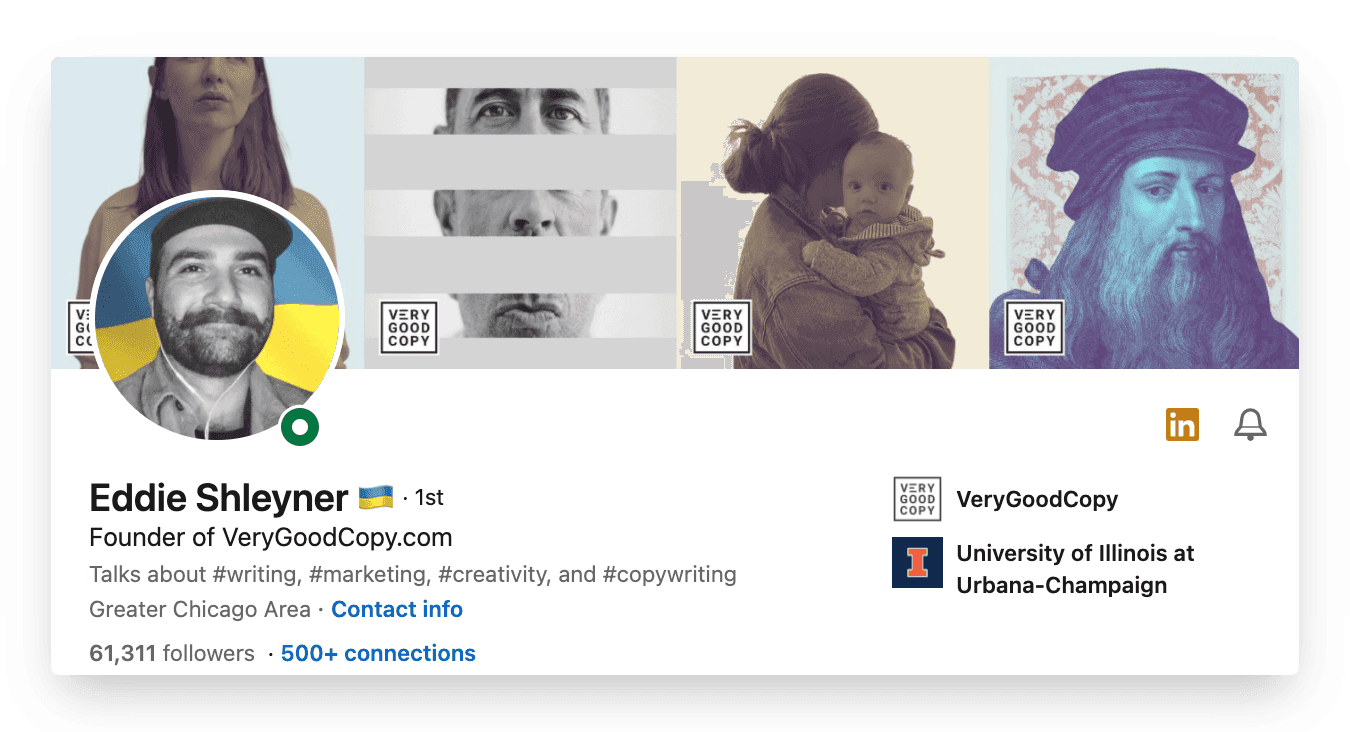
Consistent posts that add value in line with your personal brand are powerful vehicles in enforcing your stance as an industry thought leader. By providing fresh insight on a regular basis, your audience will turn to you for 'what's next?'. They will be more likely to tag their followers in your posts to share the insight. That's why updating your featured section on your profile is a great way to take control of what content you want to highlight for your profile visitors. Let's look at how Eddie is doing this ↓
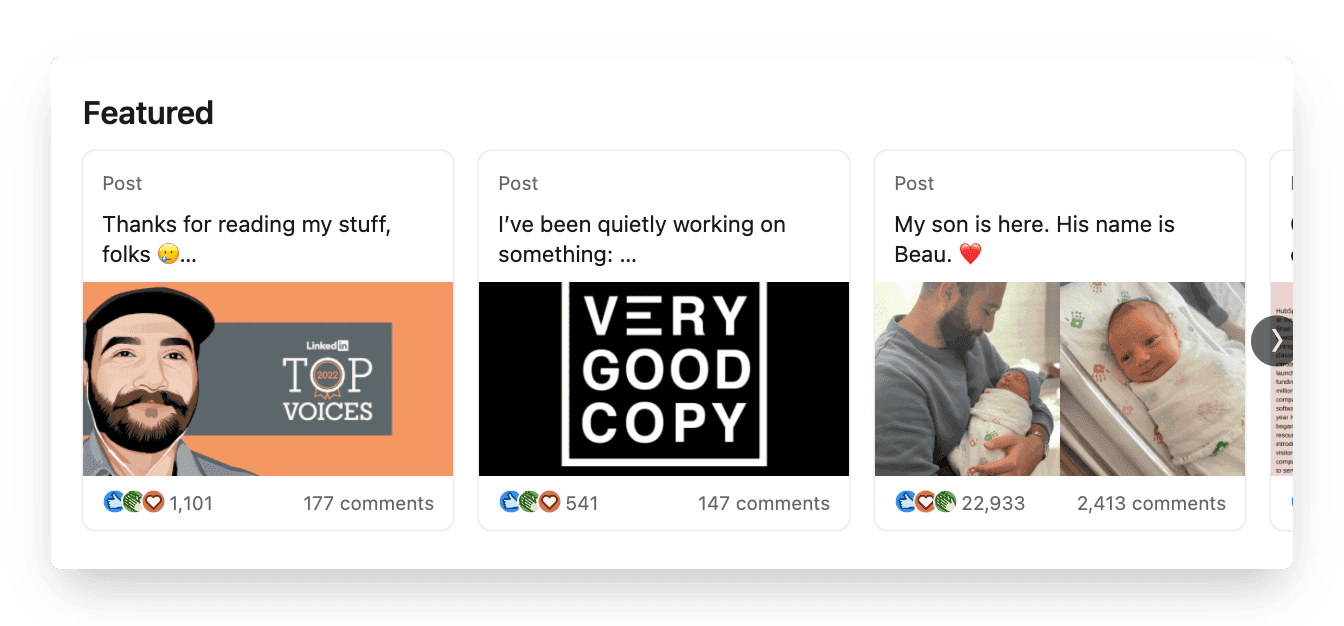
Have a look at the featured section of Andreas, CEO of Shield. He uses it with a mix of posts and links of content from the Shield Interviews to direct his audience. Use your featured section intentionally thinking about where you want to guide your audience to.
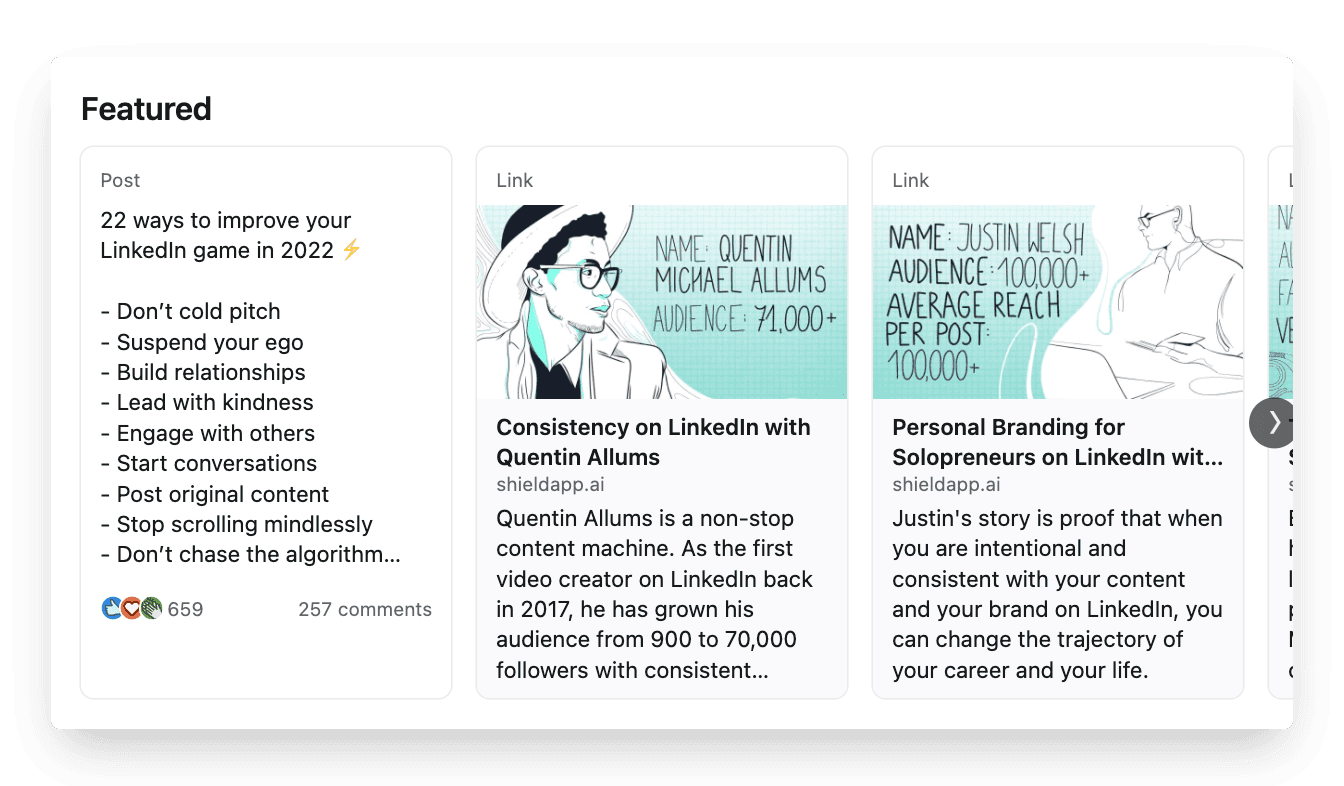
4. Humanise Your Organisation
People want to connect with people not faceless organisations. However, the latter tends to be true. Most organisations are faceless. When we want a connection with a company, we are often greeted with a logo and a chatbox. No emotion, no human, no variety. But what can we done?
When employees show up in brand colours, creating content, building trust, this inevitably leads to people having more trust in that organization. They get a sense of the humans behind the brand. Employers with strong employee advocacy programs experience a three fold benefit ↓
Sell services and products easier and faster
Recruit and retain top talent
Share your culture by encouraging employees to share their personal professional stories
Through employee advocacy, you are really able to extend your brand and give it a personality. By having employees brand their personal profiles to an organisation, it gives users the change to engage with a human and not a faceless logo. Users can ask product question, get advice, and your company always stays top of mind.
And this works the other way too. If you take your company's branding and apply it to your profile, you are instantly recognizable as representing them. You can leverage the trust and reputation of the organisation. When you back that up with value-adding content your expertise shines through and you solidify yourself as an industry expert. By using your organisation's branding, your profile can also feel more familiar to potential audience. They may already know the organisation and could feel more inclined to follow you.
Branding to your organisation can make it easier to build rapport with potential client. This can have a number of positive benefits. Including: easing the sales cycle, building relationships, and forging engaging conversations.
When potential clients or current clients follow you because of your organisation's branding it give you a chance to provide further value. Share industry leading blog posts, infographics, new product releases, case studies and more. Each bit of value you can add will help increase customer lifetime value, upsells, and improves long-term relationships.
The branding can be reflected differently in relation to the user's job title. For example, maybe the perspective of the organisation is widely different between an intern, manager, and CEO. This can help give the organisation character and make the company seem far more interesting than it otherwise would.
Below we can see the LinkedIn profiles of Filippo and Juan. Both profiles belong to Shield employees. Their profile branding helps link the profiles together and helps amplify the Shield brand. You were aware of Shield and already follow on of the profile, you'll be more likely to follow the other profile, knowing they also belong to Shield. This creates coherence and familiarity.
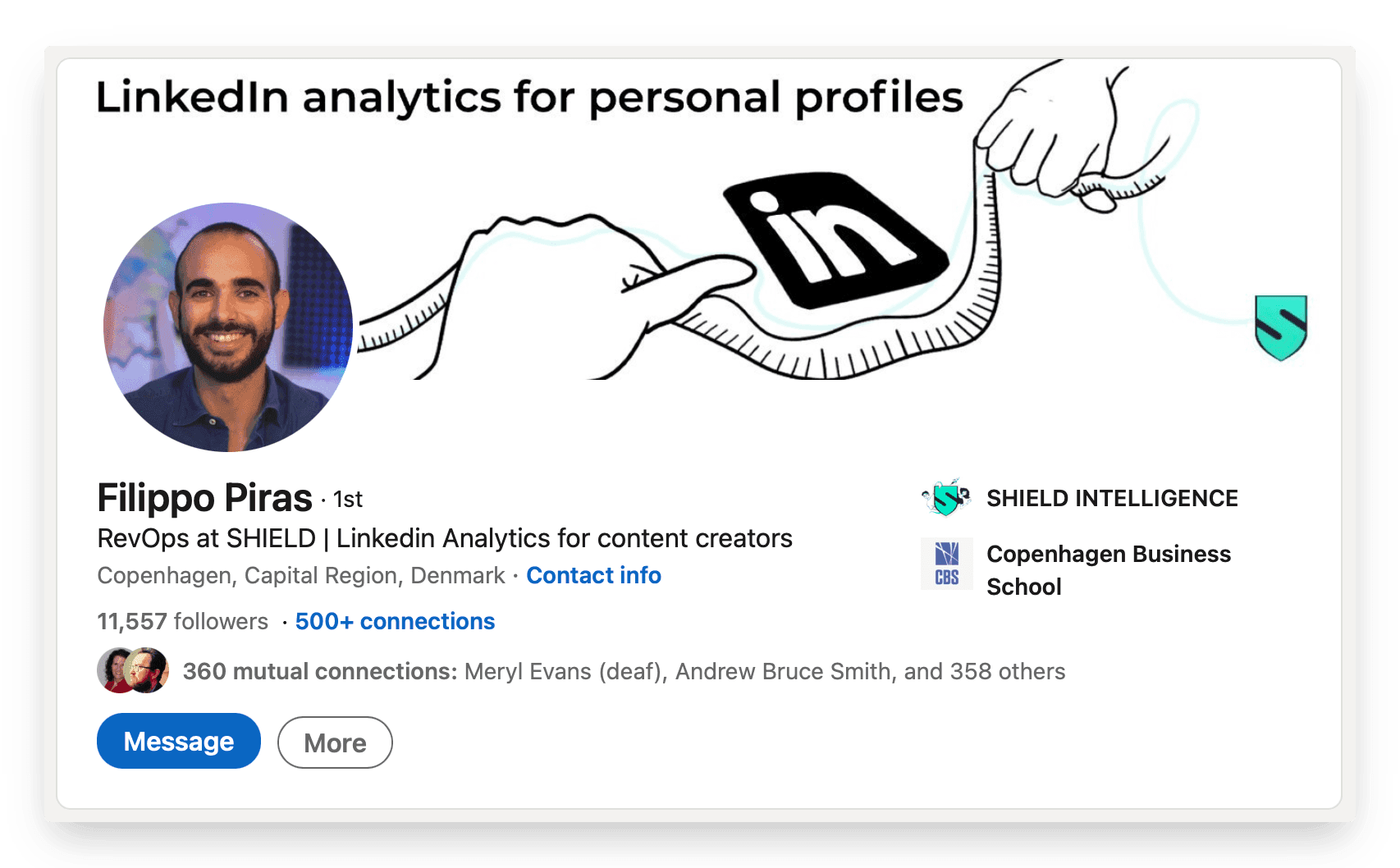
Filippo with Shield cover picture
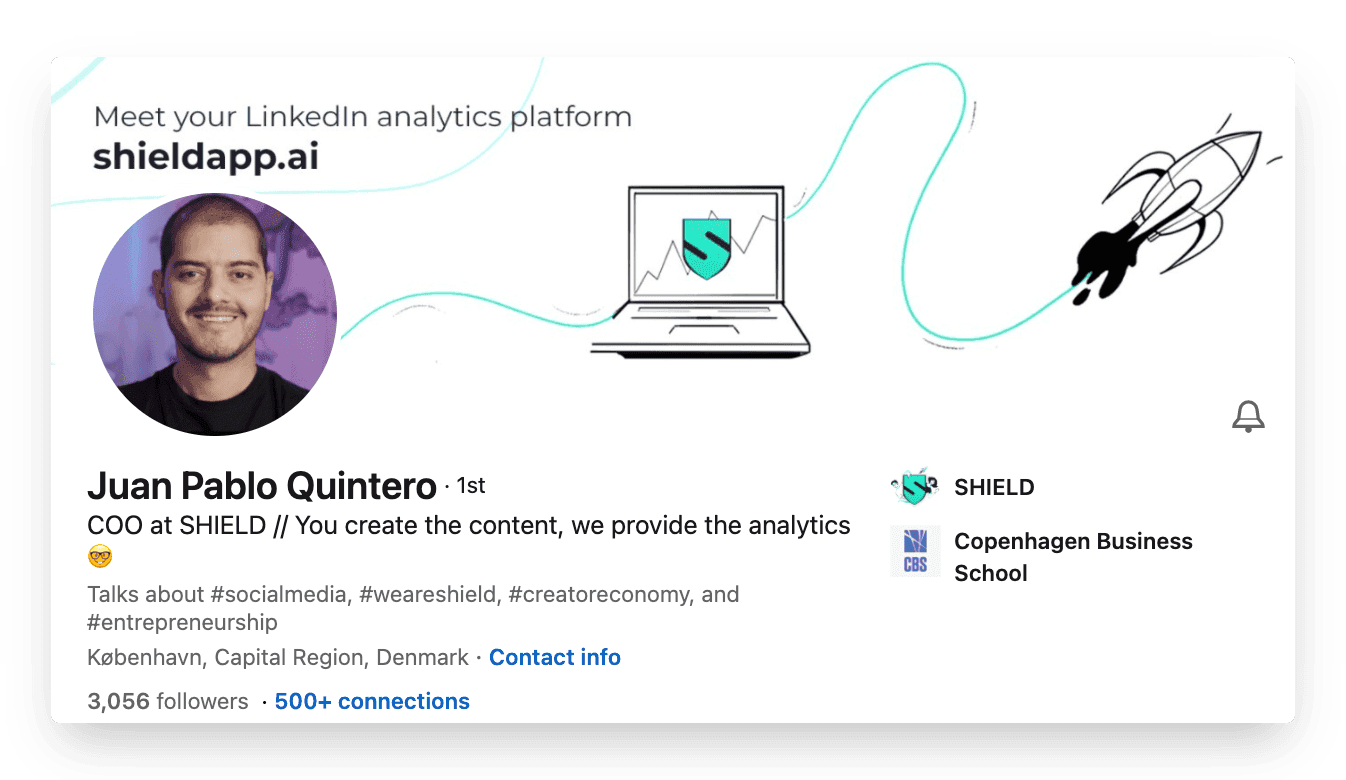
Filippo with Shield cover picture
5. Build an engaged audience
It's all well and good having a large audience, however, if they're not engaged what's the point? If your audience is unengaged, it means your high-effort posts are being wasted and falling on deaf ears.
Being able to harness the power of your audience and getting them to interact with you can provide huge benefits.
But how do you do it?
You'll first need to build a following. There are many ways to do this. For example, planning a unique posting strategy can be a great way to attract an audience. By providing a new experience, or fresh insights for those in your field, you are likely to stand out and attract attention.
Another great tip for building up a following is to post high quality content constantly. Each time you post, ensure that you are adding value. Maybe you are offering actionable advice, a new tip, or fresh data. If LinkedIn users see you deliver the goods consistently, they will be more likely to hit the follow button. Learn more here.
Over time through consistent posting, you will build a loyal following who are waiting with bated breath for your next post.
By being consistent and staying on brand, your audience will know what to expect from you. From building your reputation, they will have high levels of trust for what you post. This can also be extremely handy if you ever decide to launch a business, product, or website. You will already have an audience that will trust what you put out there.
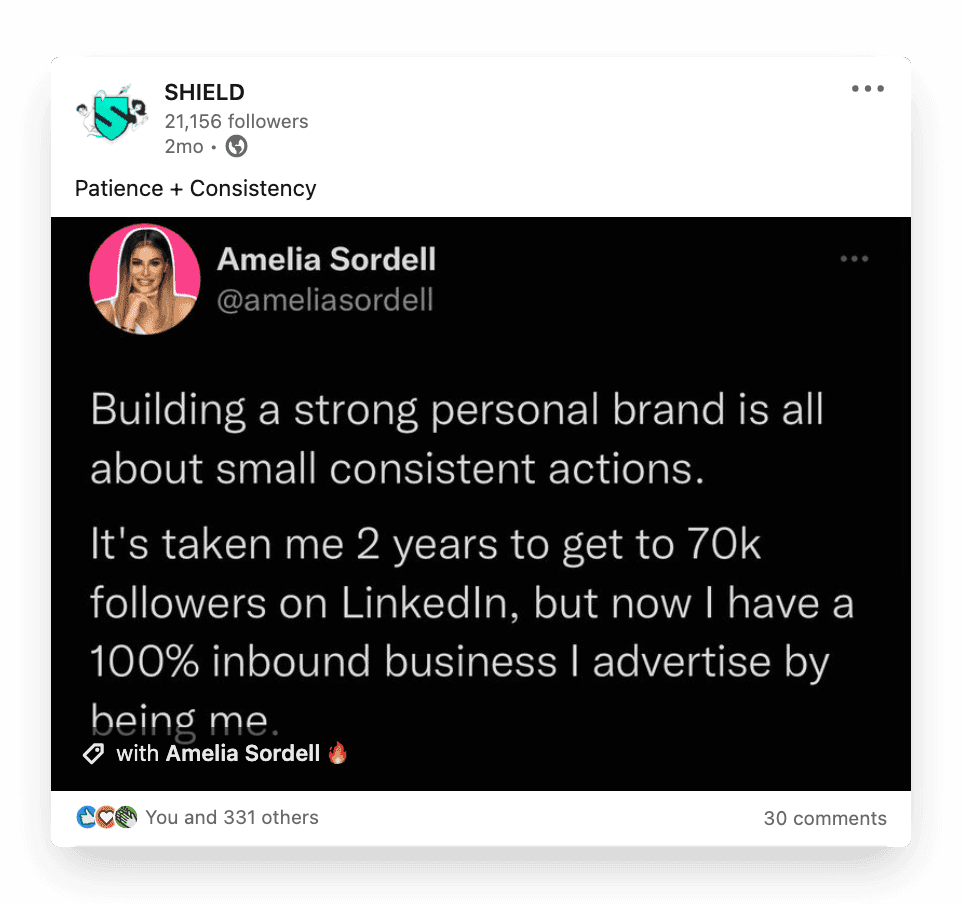
Another very impactful way to create an engaged audience is to comment on others' post. It is one of the most powerful ways of building a real meaningful relationships. When you comment on someone's content, you show intent by taking the time to read, and engage thoughtfully.
There are huge benefits to crafting an engaged audience. For example, if more people are engaging with your content it means they are more likely to react to it, comment, tag their friends, or share it. And what does this mean? It means your content is being shared to their network. This massively extends your organic reach and can lead to increased growth of your LinkedIn profile.
Being able to appear on your followers feeds, can have a domino effect. Your content may appear on your followers feed, and their followers share it. Then it appears on their feed, and then their followers share it. This network web can massively increase the chances of your content going viral. In turn, this gives you the chance to rapidly grow your audience. It's a win-win.
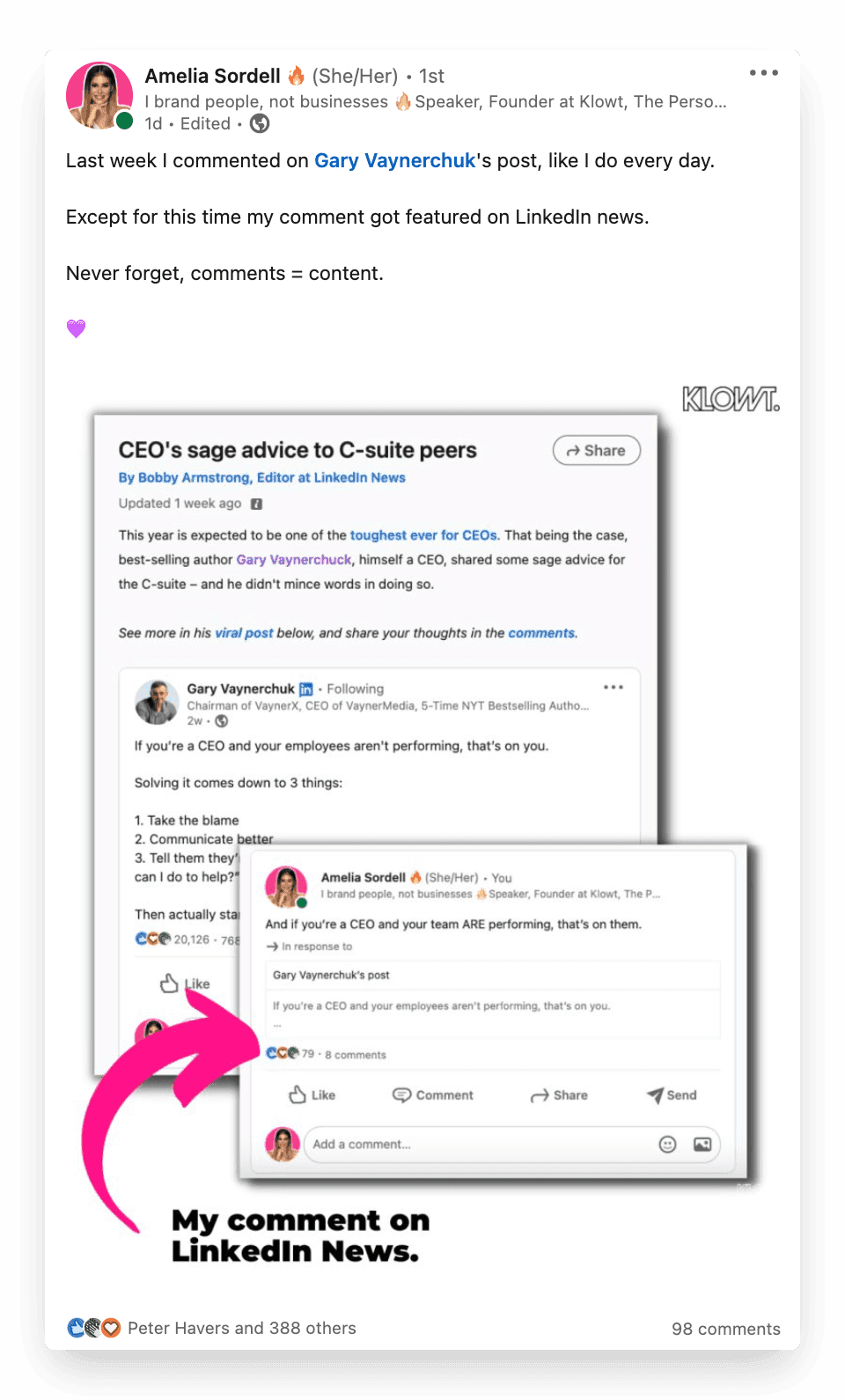
By now, we've hopefully convinced you on how important personal branding is and what benefits it can bring. Personal branding will help you in terms of audience growth, career opportunities and establishing your expertise.
It's not just you who benefits from personal branding. If you are able to add value, share your experiences you are also helping so many others who might be on a similar professional journey as you.
No matter how you plan to utilise your personal brand, it's likely to have a huge positive effects. But what can you do now to start building your personal brand?
Here's a quick checklist to get you started:
Determine what interests you
Plan out a content schedule
Define your audience
Choose some personal brand colours
Pick some key goals
Look at your profile and check if it says what you want to communicate
Start commenting on others content
As easy as that!
And if you are new to posting on LinkedIn, read our top 4 tips to get ready for your first LinkedIn post.
See you,
Personal branding is probably a term you have increasingly heard more of on LinkedIn. So what does personal branding actually mean?
In this blog, we're going to introduce personal branding and give you 5 reasons why it is important. We'll be doing this by sharing anecdotes from the SHIELD team, LinkedIn influencers, and creators on the platform.
What is personal branding?
To put it simply. Personal branding is your reputation. So if you are taking the time to intentionally work on how others perceive you, you are essentially working on your personal brand!
For example, maybe you've written blogs or articles on the latest developments and technologies in your industry. You would begin to build a reputation as a thought-leader. When you write and publish publicly and do it consistently people begin to perceive you as someone who is an expert and a thought leader. Now that's you building your personal brand. Something recognisable and familiar.
So why should you consider building your reputation on LinkedIn? What unique benefits can strong personal branding on LinkedIn give you compared to other platforms?

These are all questions we will answer in this blog.
There are many reasons why the popularity of personal branding has shot up in recent times. One of the main reasons are employment and career growth. And for those looking to start their own thing, this is the best way to build credibility in the market.
In an employment scene more competitive than ever, you need to stand out amongst the competition and be a no-brainer option for the hirer.
Other reasons include generating a sense of expertise, and for users to more efficiently grow their networks.
In this blog, we're going to take a look at 5 top reasons why personal branding on LinkedIn is important.
If you invest time and build your personal brand, you are taking control of your reputation in your hands. Within the first few months of consistently creating content, you will notice benefits flowing in. The top 5 benefits you will see ↓
Take control of your reputation
Get your dream job
Make a fantastic first impression
Build an engaged audience
Humanize your organization
Here we go!
1. Take control of your reputation
"The only way to treat a LinkedIn profile is like a website's landing page."
Your personal brand is akin to a landing page. Let me explain how → A website's landing page gives a user the first impression of the company and its products.
When a user enters a landing page, they are looking and scanning different elements. This helps them come to a number of decisions. These could be:
Do I trust this company? Do they provide what I need? Do I like them? Is it easy to use? Do others trust them?
This is a non-exhaustive list, but ultimately these decisions lead a website visitor to buy the services of a company or not. If they like the page, they may stay, consume content and get in touch. If they don't like the page, they may leave and business is lost.
Think of personal branding as your landing page for your reputation. When someone visits your profile for the first time they will look at what you talk about and try to gauge your knowledge. Can they trust your judgement? Are you an expert? Are you professional? Are you consistent?
With no personal branding, one might find it hard to answer these questions and may go elsewhere for their insight.
Therefore, it is critical you have your profile optimized so you can guide your profile visitors to the right content. When you create content on LinkedIn, you control the narrative. You control your own story and you decide what others think of you.

Maybe you're using LinkedIn for finding your next career move establishing thought-leadership, or to simply to grow your network and connect with others. Whatever your use, personal branding is a great vehicle. To get a head start on enhancing your reputation, start by optimising your profile and getting into a consistent posting routine.
You don't have to do this all in one go. Start out small and build out step by step. Don't worry about getting brand colours, tones or tag lines. This happens over time. So don't get put off by larger creators or influencers with finished products. Remember, they started out just like you! You're most likely seeing the 10th, 20th or beyond iteration of their profile. Don't let it stop you from exploring the wonders of personal branding yourself.
We all already have a personal brand. This is because you already have a reputation and will come to mind for people for certain things. Maybe one of your friends needs advice about social media marketing, and you're the first one to pop in their head.
Personal branding will take this a step further. It takes control of the reputation others have of you and turns it into your very own brand. And it expands your circle beyond the people you know around you at work.
"That's the beauty of LinkedIn. You have the opportunity to build relationships with people around the globe."
By delivering consistent high-quality content, your audience will end up expecting a high level of insight for you. This can help transform you into a thought-leader in your field. Being consistent is critical across all your personal branding. Let's take colours for example. By being consistent over a number of decades some businesses are recognisable on their brand colours alone. Take a look at the colours below. What brand do you think of?

Did you guess Coca Cola? If so you're right!
In fact, Coca Cola's colour branding has been so successful, they even have the rights to the colour. It's called "Coke Red". This way, they ensure they're the only company in the world to use this exact colour, and when people see it they immediately think of Coca Cola and all the emotions that come with it. Good marketing!
But what about people? Are colours making their mark here too?
Let's look at some examples!
Take this example from Amelia Sordell's profile. By using strong brand colours (purple + pink), Amelia is able to make her content and profile stand out with ease. After consuming her content multiple times, her audience will be able to easily recognise a post is from her just by seeing the brand colours. If they trust and think Amelia has a high level of expertise, the post will evoke these emotions too.

Here's another great example from Will Allred.
You can see how the purple from Lavender translates nicely across the header image and profile picture. When users land on Will's page they will quickly realise he is professional and knows a lot about email! Bonus kudos to Will for branding himself as "the email guy"!

When you build a personal brand with intention you stay top-of-mind for others to go to. Whether it's for employment, advice, leadership, or expertise, if you are known for a particular thing, others will think of you when they think of that particular thing. For example, with Will Allred, when people think about needing help optimising their email, Will might be the first person to come to mind. This will have positive ramifications on his company and his audience growth.
The great thing about personal branding is that your content is doing the work for you. Instead of literally saying "I am the best content marketer on the planet", you show off your expertise through insightful posts, and great content marketing on your profile. When people visit your profile they can tell you're a good content marketer just from the content you post.
2. Get your dream job
The competition in the job market is more fierce than ever. This has especially been the case since the sharp uptick in remote working. This means the job candidate pool no longer resides in a strict geographical boundary. Now, people are able to apply for most jobs from anywhere in the world. For this reason, it's become more important than ever to ensure you stand out amongst the competition and make yourself a no-brainer for any employer.
By optimising your personal brand and positioning yourself as an expert in your field, you can gain a huge advantage in the employment market. Putting some effort and consideration into your personal brand will take you far.
When you consistently create and publish great content, your audience will be playing close attention. They could be CEOs, business owners, managers, or employers. These are all people who could be looking for potential hires. Creating content on LinkedIn has this very unique benefit in comparison to other platforms. A real example from our team is how Pragya got hired!

The opportunities for employment on LinkedIn are huge and there's so much you can do to benefit your own employment journey. As your audience's trust grows in you and you become an expert in your field, you are more likely to attract employers.
A powerful personal brand flips the script from you looking for a job to jobs looking for you. When your content shows up consistently in the feed of hiring mangers, you stay top of mind when there is a position open. And your personal brand acts like your dynamic digital CV, constantly evolving and bringing new people to your network. Follow this simple list from Filippo to use LinkedIn content creation to land yourself your dream job.

3. Make a fantastic first impression
First impressions are everything... Walking into a shop, a job, a potential partner, getting into a new car, or clicking on a LinkedIn profile, these first impressions matter.
The first time you see a LinkedIn profile, you start to form opinions on the owner of the profile. You will think are they an expert? Are they trustworthy? Do they post often? Are they professional? All these questions will lead to an ultimate decision on whether to click the follow button or not.
Coming across a nice, consistently branded LinkedIn profile is rare. When looking for new people to follow, you most likely look for something different or for new insight. If you don't detect either of these, it's just another profile. Therefore, you need to stand out.
By correctly aligning visual media, colours, and text to your personal brand, you can make a great first impression to anyone who visits your profile.Maybe have a think and come up with a colour that matches your personality. Then sprinkle it into your profile picture, header and content. After a while of consistent posting, your audience will begin to notice your content by colour alone.
Eddie's profile is a great example of how he uses images from his website VeryGoodCopy as his background picture. This creates familiarity when his newsletter subscribers end up on his LinkedIn profile.

Consistent posts that add value in line with your personal brand are powerful vehicles in enforcing your stance as an industry thought leader. By providing fresh insight on a regular basis, your audience will turn to you for 'what's next?'. They will be more likely to tag their followers in your posts to share the insight. That's why updating your featured section on your profile is a great way to take control of what content you want to highlight for your profile visitors. Let's look at how Eddie is doing this ↓

Have a look at the featured section of Andreas, CEO of Shield. He uses it with a mix of posts and links of content from the Shield Interviews to direct his audience. Use your featured section intentionally thinking about where you want to guide your audience to.

4. Humanise Your Organisation
People want to connect with people not faceless organisations. However, the latter tends to be true. Most organisations are faceless. When we want a connection with a company, we are often greeted with a logo and a chatbox. No emotion, no human, no variety. But what can we done?
When employees show up in brand colours, creating content, building trust, this inevitably leads to people having more trust in that organization. They get a sense of the humans behind the brand. Employers with strong employee advocacy programs experience a three fold benefit ↓
Sell services and products easier and faster
Recruit and retain top talent
Share your culture by encouraging employees to share their personal professional stories
Through employee advocacy, you are really able to extend your brand and give it a personality. By having employees brand their personal profiles to an organisation, it gives users the change to engage with a human and not a faceless logo. Users can ask product question, get advice, and your company always stays top of mind.
And this works the other way too. If you take your company's branding and apply it to your profile, you are instantly recognizable as representing them. You can leverage the trust and reputation of the organisation. When you back that up with value-adding content your expertise shines through and you solidify yourself as an industry expert. By using your organisation's branding, your profile can also feel more familiar to potential audience. They may already know the organisation and could feel more inclined to follow you.
Branding to your organisation can make it easier to build rapport with potential client. This can have a number of positive benefits. Including: easing the sales cycle, building relationships, and forging engaging conversations.
When potential clients or current clients follow you because of your organisation's branding it give you a chance to provide further value. Share industry leading blog posts, infographics, new product releases, case studies and more. Each bit of value you can add will help increase customer lifetime value, upsells, and improves long-term relationships.
The branding can be reflected differently in relation to the user's job title. For example, maybe the perspective of the organisation is widely different between an intern, manager, and CEO. This can help give the organisation character and make the company seem far more interesting than it otherwise would.
Below we can see the LinkedIn profiles of Filippo and Juan. Both profiles belong to Shield employees. Their profile branding helps link the profiles together and helps amplify the Shield brand. You were aware of Shield and already follow on of the profile, you'll be more likely to follow the other profile, knowing they also belong to Shield. This creates coherence and familiarity.

Filippo with Shield cover picture

Filippo with Shield cover picture
5. Build an engaged audience
It's all well and good having a large audience, however, if they're not engaged what's the point? If your audience is unengaged, it means your high-effort posts are being wasted and falling on deaf ears.
Being able to harness the power of your audience and getting them to interact with you can provide huge benefits.
But how do you do it?
You'll first need to build a following. There are many ways to do this. For example, planning a unique posting strategy can be a great way to attract an audience. By providing a new experience, or fresh insights for those in your field, you are likely to stand out and attract attention.
Another great tip for building up a following is to post high quality content constantly. Each time you post, ensure that you are adding value. Maybe you are offering actionable advice, a new tip, or fresh data. If LinkedIn users see you deliver the goods consistently, they will be more likely to hit the follow button. Learn more here.
Over time through consistent posting, you will build a loyal following who are waiting with bated breath for your next post.
By being consistent and staying on brand, your audience will know what to expect from you. From building your reputation, they will have high levels of trust for what you post. This can also be extremely handy if you ever decide to launch a business, product, or website. You will already have an audience that will trust what you put out there.

Another very impactful way to create an engaged audience is to comment on others' post. It is one of the most powerful ways of building a real meaningful relationships. When you comment on someone's content, you show intent by taking the time to read, and engage thoughtfully.
There are huge benefits to crafting an engaged audience. For example, if more people are engaging with your content it means they are more likely to react to it, comment, tag their friends, or share it. And what does this mean? It means your content is being shared to their network. This massively extends your organic reach and can lead to increased growth of your LinkedIn profile.
Being able to appear on your followers feeds, can have a domino effect. Your content may appear on your followers feed, and their followers share it. Then it appears on their feed, and then their followers share it. This network web can massively increase the chances of your content going viral. In turn, this gives you the chance to rapidly grow your audience. It's a win-win.

By now, we've hopefully convinced you on how important personal branding is and what benefits it can bring. Personal branding will help you in terms of audience growth, career opportunities and establishing your expertise.
It's not just you who benefits from personal branding. If you are able to add value, share your experiences you are also helping so many others who might be on a similar professional journey as you.
No matter how you plan to utilise your personal brand, it's likely to have a huge positive effects. But what can you do now to start building your personal brand?
Here's a quick checklist to get you started:
Determine what interests you
Plan out a content schedule
Define your audience
Choose some personal brand colours
Pick some key goals
Look at your profile and check if it says what you want to communicate
Start commenting on others content
As easy as that!
And if you are new to posting on LinkedIn, read our top 4 tips to get ready for your first LinkedIn post.
See you,
Personal branding is probably a term you have increasingly heard more of on LinkedIn. So what does personal branding actually mean?
In this blog, we're going to introduce personal branding and give you 5 reasons why it is important. We'll be doing this by sharing anecdotes from the SHIELD team, LinkedIn influencers, and creators on the platform.
What is personal branding?
To put it simply. Personal branding is your reputation. So if you are taking the time to intentionally work on how others perceive you, you are essentially working on your personal brand!
For example, maybe you've written blogs or articles on the latest developments and technologies in your industry. You would begin to build a reputation as a thought-leader. When you write and publish publicly and do it consistently people begin to perceive you as someone who is an expert and a thought leader. Now that's you building your personal brand. Something recognisable and familiar.
So why should you consider building your reputation on LinkedIn? What unique benefits can strong personal branding on LinkedIn give you compared to other platforms?

These are all questions we will answer in this blog.
There are many reasons why the popularity of personal branding has shot up in recent times. One of the main reasons are employment and career growth. And for those looking to start their own thing, this is the best way to build credibility in the market.
In an employment scene more competitive than ever, you need to stand out amongst the competition and be a no-brainer option for the hirer.
Other reasons include generating a sense of expertise, and for users to more efficiently grow their networks.
In this blog, we're going to take a look at 5 top reasons why personal branding on LinkedIn is important.
If you invest time and build your personal brand, you are taking control of your reputation in your hands. Within the first few months of consistently creating content, you will notice benefits flowing in. The top 5 benefits you will see ↓
Take control of your reputation
Get your dream job
Make a fantastic first impression
Build an engaged audience
Humanize your organization
Here we go!
1. Take control of your reputation
"The only way to treat a LinkedIn profile is like a website's landing page."
Your personal brand is akin to a landing page. Let me explain how → A website's landing page gives a user the first impression of the company and its products.
When a user enters a landing page, they are looking and scanning different elements. This helps them come to a number of decisions. These could be:
Do I trust this company? Do they provide what I need? Do I like them? Is it easy to use? Do others trust them?
This is a non-exhaustive list, but ultimately these decisions lead a website visitor to buy the services of a company or not. If they like the page, they may stay, consume content and get in touch. If they don't like the page, they may leave and business is lost.
Think of personal branding as your landing page for your reputation. When someone visits your profile for the first time they will look at what you talk about and try to gauge your knowledge. Can they trust your judgement? Are you an expert? Are you professional? Are you consistent?
With no personal branding, one might find it hard to answer these questions and may go elsewhere for their insight.
Therefore, it is critical you have your profile optimized so you can guide your profile visitors to the right content. When you create content on LinkedIn, you control the narrative. You control your own story and you decide what others think of you.

Maybe you're using LinkedIn for finding your next career move establishing thought-leadership, or to simply to grow your network and connect with others. Whatever your use, personal branding is a great vehicle. To get a head start on enhancing your reputation, start by optimising your profile and getting into a consistent posting routine.
You don't have to do this all in one go. Start out small and build out step by step. Don't worry about getting brand colours, tones or tag lines. This happens over time. So don't get put off by larger creators or influencers with finished products. Remember, they started out just like you! You're most likely seeing the 10th, 20th or beyond iteration of their profile. Don't let it stop you from exploring the wonders of personal branding yourself.
We all already have a personal brand. This is because you already have a reputation and will come to mind for people for certain things. Maybe one of your friends needs advice about social media marketing, and you're the first one to pop in their head.
Personal branding will take this a step further. It takes control of the reputation others have of you and turns it into your very own brand. And it expands your circle beyond the people you know around you at work.
"That's the beauty of LinkedIn. You have the opportunity to build relationships with people around the globe."
By delivering consistent high-quality content, your audience will end up expecting a high level of insight for you. This can help transform you into a thought-leader in your field. Being consistent is critical across all your personal branding. Let's take colours for example. By being consistent over a number of decades some businesses are recognisable on their brand colours alone. Take a look at the colours below. What brand do you think of?

Did you guess Coca Cola? If so you're right!
In fact, Coca Cola's colour branding has been so successful, they even have the rights to the colour. It's called "Coke Red". This way, they ensure they're the only company in the world to use this exact colour, and when people see it they immediately think of Coca Cola and all the emotions that come with it. Good marketing!
But what about people? Are colours making their mark here too?
Let's look at some examples!
Take this example from Amelia Sordell's profile. By using strong brand colours (purple + pink), Amelia is able to make her content and profile stand out with ease. After consuming her content multiple times, her audience will be able to easily recognise a post is from her just by seeing the brand colours. If they trust and think Amelia has a high level of expertise, the post will evoke these emotions too.

Here's another great example from Will Allred.
You can see how the purple from Lavender translates nicely across the header image and profile picture. When users land on Will's page they will quickly realise he is professional and knows a lot about email! Bonus kudos to Will for branding himself as "the email guy"!

When you build a personal brand with intention you stay top-of-mind for others to go to. Whether it's for employment, advice, leadership, or expertise, if you are known for a particular thing, others will think of you when they think of that particular thing. For example, with Will Allred, when people think about needing help optimising their email, Will might be the first person to come to mind. This will have positive ramifications on his company and his audience growth.
The great thing about personal branding is that your content is doing the work for you. Instead of literally saying "I am the best content marketer on the planet", you show off your expertise through insightful posts, and great content marketing on your profile. When people visit your profile they can tell you're a good content marketer just from the content you post.
2. Get your dream job
The competition in the job market is more fierce than ever. This has especially been the case since the sharp uptick in remote working. This means the job candidate pool no longer resides in a strict geographical boundary. Now, people are able to apply for most jobs from anywhere in the world. For this reason, it's become more important than ever to ensure you stand out amongst the competition and make yourself a no-brainer for any employer.
By optimising your personal brand and positioning yourself as an expert in your field, you can gain a huge advantage in the employment market. Putting some effort and consideration into your personal brand will take you far.
When you consistently create and publish great content, your audience will be playing close attention. They could be CEOs, business owners, managers, or employers. These are all people who could be looking for potential hires. Creating content on LinkedIn has this very unique benefit in comparison to other platforms. A real example from our team is how Pragya got hired!

The opportunities for employment on LinkedIn are huge and there's so much you can do to benefit your own employment journey. As your audience's trust grows in you and you become an expert in your field, you are more likely to attract employers.
A powerful personal brand flips the script from you looking for a job to jobs looking for you. When your content shows up consistently in the feed of hiring mangers, you stay top of mind when there is a position open. And your personal brand acts like your dynamic digital CV, constantly evolving and bringing new people to your network. Follow this simple list from Filippo to use LinkedIn content creation to land yourself your dream job.

3. Make a fantastic first impression
First impressions are everything... Walking into a shop, a job, a potential partner, getting into a new car, or clicking on a LinkedIn profile, these first impressions matter.
The first time you see a LinkedIn profile, you start to form opinions on the owner of the profile. You will think are they an expert? Are they trustworthy? Do they post often? Are they professional? All these questions will lead to an ultimate decision on whether to click the follow button or not.
Coming across a nice, consistently branded LinkedIn profile is rare. When looking for new people to follow, you most likely look for something different or for new insight. If you don't detect either of these, it's just another profile. Therefore, you need to stand out.
By correctly aligning visual media, colours, and text to your personal brand, you can make a great first impression to anyone who visits your profile.Maybe have a think and come up with a colour that matches your personality. Then sprinkle it into your profile picture, header and content. After a while of consistent posting, your audience will begin to notice your content by colour alone.
Eddie's profile is a great example of how he uses images from his website VeryGoodCopy as his background picture. This creates familiarity when his newsletter subscribers end up on his LinkedIn profile.

Consistent posts that add value in line with your personal brand are powerful vehicles in enforcing your stance as an industry thought leader. By providing fresh insight on a regular basis, your audience will turn to you for 'what's next?'. They will be more likely to tag their followers in your posts to share the insight. That's why updating your featured section on your profile is a great way to take control of what content you want to highlight for your profile visitors. Let's look at how Eddie is doing this ↓

Have a look at the featured section of Andreas, CEO of Shield. He uses it with a mix of posts and links of content from the Shield Interviews to direct his audience. Use your featured section intentionally thinking about where you want to guide your audience to.

4. Humanise Your Organisation
People want to connect with people not faceless organisations. However, the latter tends to be true. Most organisations are faceless. When we want a connection with a company, we are often greeted with a logo and a chatbox. No emotion, no human, no variety. But what can we done?
When employees show up in brand colours, creating content, building trust, this inevitably leads to people having more trust in that organization. They get a sense of the humans behind the brand. Employers with strong employee advocacy programs experience a three fold benefit ↓
Sell services and products easier and faster
Recruit and retain top talent
Share your culture by encouraging employees to share their personal professional stories
Through employee advocacy, you are really able to extend your brand and give it a personality. By having employees brand their personal profiles to an organisation, it gives users the change to engage with a human and not a faceless logo. Users can ask product question, get advice, and your company always stays top of mind.
And this works the other way too. If you take your company's branding and apply it to your profile, you are instantly recognizable as representing them. You can leverage the trust and reputation of the organisation. When you back that up with value-adding content your expertise shines through and you solidify yourself as an industry expert. By using your organisation's branding, your profile can also feel more familiar to potential audience. They may already know the organisation and could feel more inclined to follow you.
Branding to your organisation can make it easier to build rapport with potential client. This can have a number of positive benefits. Including: easing the sales cycle, building relationships, and forging engaging conversations.
When potential clients or current clients follow you because of your organisation's branding it give you a chance to provide further value. Share industry leading blog posts, infographics, new product releases, case studies and more. Each bit of value you can add will help increase customer lifetime value, upsells, and improves long-term relationships.
The branding can be reflected differently in relation to the user's job title. For example, maybe the perspective of the organisation is widely different between an intern, manager, and CEO. This can help give the organisation character and make the company seem far more interesting than it otherwise would.
Below we can see the LinkedIn profiles of Filippo and Juan. Both profiles belong to Shield employees. Their profile branding helps link the profiles together and helps amplify the Shield brand. You were aware of Shield and already follow on of the profile, you'll be more likely to follow the other profile, knowing they also belong to Shield. This creates coherence and familiarity.

Filippo with Shield cover picture

Filippo with Shield cover picture
5. Build an engaged audience
It's all well and good having a large audience, however, if they're not engaged what's the point? If your audience is unengaged, it means your high-effort posts are being wasted and falling on deaf ears.
Being able to harness the power of your audience and getting them to interact with you can provide huge benefits.
But how do you do it?
You'll first need to build a following. There are many ways to do this. For example, planning a unique posting strategy can be a great way to attract an audience. By providing a new experience, or fresh insights for those in your field, you are likely to stand out and attract attention.
Another great tip for building up a following is to post high quality content constantly. Each time you post, ensure that you are adding value. Maybe you are offering actionable advice, a new tip, or fresh data. If LinkedIn users see you deliver the goods consistently, they will be more likely to hit the follow button. Learn more here.
Over time through consistent posting, you will build a loyal following who are waiting with bated breath for your next post.
By being consistent and staying on brand, your audience will know what to expect from you. From building your reputation, they will have high levels of trust for what you post. This can also be extremely handy if you ever decide to launch a business, product, or website. You will already have an audience that will trust what you put out there.

Another very impactful way to create an engaged audience is to comment on others' post. It is one of the most powerful ways of building a real meaningful relationships. When you comment on someone's content, you show intent by taking the time to read, and engage thoughtfully.
There are huge benefits to crafting an engaged audience. For example, if more people are engaging with your content it means they are more likely to react to it, comment, tag their friends, or share it. And what does this mean? It means your content is being shared to their network. This massively extends your organic reach and can lead to increased growth of your LinkedIn profile.
Being able to appear on your followers feeds, can have a domino effect. Your content may appear on your followers feed, and their followers share it. Then it appears on their feed, and then their followers share it. This network web can massively increase the chances of your content going viral. In turn, this gives you the chance to rapidly grow your audience. It's a win-win.

By now, we've hopefully convinced you on how important personal branding is and what benefits it can bring. Personal branding will help you in terms of audience growth, career opportunities and establishing your expertise.
It's not just you who benefits from personal branding. If you are able to add value, share your experiences you are also helping so many others who might be on a similar professional journey as you.
No matter how you plan to utilise your personal brand, it's likely to have a huge positive effects. But what can you do now to start building your personal brand?
Here's a quick checklist to get you started:
Determine what interests you
Plan out a content schedule
Define your audience
Choose some personal brand colours
Pick some key goals
Look at your profile and check if it says what you want to communicate
Start commenting on others content
As easy as that!
And if you are new to posting on LinkedIn, read our top 4 tips to get ready for your first LinkedIn post.
See you,
Personal branding is probably a term you have increasingly heard more of on LinkedIn. So what does personal branding actually mean?
In this blog, we're going to introduce personal branding and give you 5 reasons why it is important. We'll be doing this by sharing anecdotes from the SHIELD team, LinkedIn influencers, and creators on the platform.
What is personal branding?
To put it simply. Personal branding is your reputation. So if you are taking the time to intentionally work on how others perceive you, you are essentially working on your personal brand!
For example, maybe you've written blogs or articles on the latest developments and technologies in your industry. You would begin to build a reputation as a thought-leader. When you write and publish publicly and do it consistently people begin to perceive you as someone who is an expert and a thought leader. Now that's you building your personal brand. Something recognisable and familiar.
So why should you consider building your reputation on LinkedIn? What unique benefits can strong personal branding on LinkedIn give you compared to other platforms?

These are all questions we will answer in this blog.
There are many reasons why the popularity of personal branding has shot up in recent times. One of the main reasons are employment and career growth. And for those looking to start their own thing, this is the best way to build credibility in the market.
In an employment scene more competitive than ever, you need to stand out amongst the competition and be a no-brainer option for the hirer.
Other reasons include generating a sense of expertise, and for users to more efficiently grow their networks.
In this blog, we're going to take a look at 5 top reasons why personal branding on LinkedIn is important.
If you invest time and build your personal brand, you are taking control of your reputation in your hands. Within the first few months of consistently creating content, you will notice benefits flowing in. The top 5 benefits you will see ↓
Take control of your reputation
Get your dream job
Make a fantastic first impression
Build an engaged audience
Humanize your organization
Here we go!
1. Take control of your reputation
"The only way to treat a LinkedIn profile is like a website's landing page."
Your personal brand is akin to a landing page. Let me explain how → A website's landing page gives a user the first impression of the company and its products.
When a user enters a landing page, they are looking and scanning different elements. This helps them come to a number of decisions. These could be:
Do I trust this company? Do they provide what I need? Do I like them? Is it easy to use? Do others trust them?
This is a non-exhaustive list, but ultimately these decisions lead a website visitor to buy the services of a company or not. If they like the page, they may stay, consume content and get in touch. If they don't like the page, they may leave and business is lost.
Think of personal branding as your landing page for your reputation. When someone visits your profile for the first time they will look at what you talk about and try to gauge your knowledge. Can they trust your judgement? Are you an expert? Are you professional? Are you consistent?
With no personal branding, one might find it hard to answer these questions and may go elsewhere for their insight.
Therefore, it is critical you have your profile optimized so you can guide your profile visitors to the right content. When you create content on LinkedIn, you control the narrative. You control your own story and you decide what others think of you.

Maybe you're using LinkedIn for finding your next career move establishing thought-leadership, or to simply to grow your network and connect with others. Whatever your use, personal branding is a great vehicle. To get a head start on enhancing your reputation, start by optimising your profile and getting into a consistent posting routine.
You don't have to do this all in one go. Start out small and build out step by step. Don't worry about getting brand colours, tones or tag lines. This happens over time. So don't get put off by larger creators or influencers with finished products. Remember, they started out just like you! You're most likely seeing the 10th, 20th or beyond iteration of their profile. Don't let it stop you from exploring the wonders of personal branding yourself.
We all already have a personal brand. This is because you already have a reputation and will come to mind for people for certain things. Maybe one of your friends needs advice about social media marketing, and you're the first one to pop in their head.
Personal branding will take this a step further. It takes control of the reputation others have of you and turns it into your very own brand. And it expands your circle beyond the people you know around you at work.
"That's the beauty of LinkedIn. You have the opportunity to build relationships with people around the globe."
By delivering consistent high-quality content, your audience will end up expecting a high level of insight for you. This can help transform you into a thought-leader in your field. Being consistent is critical across all your personal branding. Let's take colours for example. By being consistent over a number of decades some businesses are recognisable on their brand colours alone. Take a look at the colours below. What brand do you think of?

Did you guess Coca Cola? If so you're right!
In fact, Coca Cola's colour branding has been so successful, they even have the rights to the colour. It's called "Coke Red". This way, they ensure they're the only company in the world to use this exact colour, and when people see it they immediately think of Coca Cola and all the emotions that come with it. Good marketing!
But what about people? Are colours making their mark here too?
Let's look at some examples!
Take this example from Amelia Sordell's profile. By using strong brand colours (purple + pink), Amelia is able to make her content and profile stand out with ease. After consuming her content multiple times, her audience will be able to easily recognise a post is from her just by seeing the brand colours. If they trust and think Amelia has a high level of expertise, the post will evoke these emotions too.

Here's another great example from Will Allred.
You can see how the purple from Lavender translates nicely across the header image and profile picture. When users land on Will's page they will quickly realise he is professional and knows a lot about email! Bonus kudos to Will for branding himself as "the email guy"!

When you build a personal brand with intention you stay top-of-mind for others to go to. Whether it's for employment, advice, leadership, or expertise, if you are known for a particular thing, others will think of you when they think of that particular thing. For example, with Will Allred, when people think about needing help optimising their email, Will might be the first person to come to mind. This will have positive ramifications on his company and his audience growth.
The great thing about personal branding is that your content is doing the work for you. Instead of literally saying "I am the best content marketer on the planet", you show off your expertise through insightful posts, and great content marketing on your profile. When people visit your profile they can tell you're a good content marketer just from the content you post.
2. Get your dream job
The competition in the job market is more fierce than ever. This has especially been the case since the sharp uptick in remote working. This means the job candidate pool no longer resides in a strict geographical boundary. Now, people are able to apply for most jobs from anywhere in the world. For this reason, it's become more important than ever to ensure you stand out amongst the competition and make yourself a no-brainer for any employer.
By optimising your personal brand and positioning yourself as an expert in your field, you can gain a huge advantage in the employment market. Putting some effort and consideration into your personal brand will take you far.
When you consistently create and publish great content, your audience will be playing close attention. They could be CEOs, business owners, managers, or employers. These are all people who could be looking for potential hires. Creating content on LinkedIn has this very unique benefit in comparison to other platforms. A real example from our team is how Pragya got hired!

The opportunities for employment on LinkedIn are huge and there's so much you can do to benefit your own employment journey. As your audience's trust grows in you and you become an expert in your field, you are more likely to attract employers.
A powerful personal brand flips the script from you looking for a job to jobs looking for you. When your content shows up consistently in the feed of hiring mangers, you stay top of mind when there is a position open. And your personal brand acts like your dynamic digital CV, constantly evolving and bringing new people to your network. Follow this simple list from Filippo to use LinkedIn content creation to land yourself your dream job.

3. Make a fantastic first impression
First impressions are everything... Walking into a shop, a job, a potential partner, getting into a new car, or clicking on a LinkedIn profile, these first impressions matter.
The first time you see a LinkedIn profile, you start to form opinions on the owner of the profile. You will think are they an expert? Are they trustworthy? Do they post often? Are they professional? All these questions will lead to an ultimate decision on whether to click the follow button or not.
Coming across a nice, consistently branded LinkedIn profile is rare. When looking for new people to follow, you most likely look for something different or for new insight. If you don't detect either of these, it's just another profile. Therefore, you need to stand out.
By correctly aligning visual media, colours, and text to your personal brand, you can make a great first impression to anyone who visits your profile.Maybe have a think and come up with a colour that matches your personality. Then sprinkle it into your profile picture, header and content. After a while of consistent posting, your audience will begin to notice your content by colour alone.
Eddie's profile is a great example of how he uses images from his website VeryGoodCopy as his background picture. This creates familiarity when his newsletter subscribers end up on his LinkedIn profile.

Consistent posts that add value in line with your personal brand are powerful vehicles in enforcing your stance as an industry thought leader. By providing fresh insight on a regular basis, your audience will turn to you for 'what's next?'. They will be more likely to tag their followers in your posts to share the insight. That's why updating your featured section on your profile is a great way to take control of what content you want to highlight for your profile visitors. Let's look at how Eddie is doing this ↓

Have a look at the featured section of Andreas, CEO of Shield. He uses it with a mix of posts and links of content from the Shield Interviews to direct his audience. Use your featured section intentionally thinking about where you want to guide your audience to.

4. Humanise Your Organisation
People want to connect with people not faceless organisations. However, the latter tends to be true. Most organisations are faceless. When we want a connection with a company, we are often greeted with a logo and a chatbox. No emotion, no human, no variety. But what can we done?
When employees show up in brand colours, creating content, building trust, this inevitably leads to people having more trust in that organization. They get a sense of the humans behind the brand. Employers with strong employee advocacy programs experience a three fold benefit ↓
Sell services and products easier and faster
Recruit and retain top talent
Share your culture by encouraging employees to share their personal professional stories
Through employee advocacy, you are really able to extend your brand and give it a personality. By having employees brand their personal profiles to an organisation, it gives users the change to engage with a human and not a faceless logo. Users can ask product question, get advice, and your company always stays top of mind.
And this works the other way too. If you take your company's branding and apply it to your profile, you are instantly recognizable as representing them. You can leverage the trust and reputation of the organisation. When you back that up with value-adding content your expertise shines through and you solidify yourself as an industry expert. By using your organisation's branding, your profile can also feel more familiar to potential audience. They may already know the organisation and could feel more inclined to follow you.
Branding to your organisation can make it easier to build rapport with potential client. This can have a number of positive benefits. Including: easing the sales cycle, building relationships, and forging engaging conversations.
When potential clients or current clients follow you because of your organisation's branding it give you a chance to provide further value. Share industry leading blog posts, infographics, new product releases, case studies and more. Each bit of value you can add will help increase customer lifetime value, upsells, and improves long-term relationships.
The branding can be reflected differently in relation to the user's job title. For example, maybe the perspective of the organisation is widely different between an intern, manager, and CEO. This can help give the organisation character and make the company seem far more interesting than it otherwise would.
Below we can see the LinkedIn profiles of Filippo and Juan. Both profiles belong to Shield employees. Their profile branding helps link the profiles together and helps amplify the Shield brand. You were aware of Shield and already follow on of the profile, you'll be more likely to follow the other profile, knowing they also belong to Shield. This creates coherence and familiarity.

Filippo with Shield cover picture

Filippo with Shield cover picture
5. Build an engaged audience
It's all well and good having a large audience, however, if they're not engaged what's the point? If your audience is unengaged, it means your high-effort posts are being wasted and falling on deaf ears.
Being able to harness the power of your audience and getting them to interact with you can provide huge benefits.
But how do you do it?
You'll first need to build a following. There are many ways to do this. For example, planning a unique posting strategy can be a great way to attract an audience. By providing a new experience, or fresh insights for those in your field, you are likely to stand out and attract attention.
Another great tip for building up a following is to post high quality content constantly. Each time you post, ensure that you are adding value. Maybe you are offering actionable advice, a new tip, or fresh data. If LinkedIn users see you deliver the goods consistently, they will be more likely to hit the follow button. Learn more here.
Over time through consistent posting, you will build a loyal following who are waiting with bated breath for your next post.
By being consistent and staying on brand, your audience will know what to expect from you. From building your reputation, they will have high levels of trust for what you post. This can also be extremely handy if you ever decide to launch a business, product, or website. You will already have an audience that will trust what you put out there.

Another very impactful way to create an engaged audience is to comment on others' post. It is one of the most powerful ways of building a real meaningful relationships. When you comment on someone's content, you show intent by taking the time to read, and engage thoughtfully.
There are huge benefits to crafting an engaged audience. For example, if more people are engaging with your content it means they are more likely to react to it, comment, tag their friends, or share it. And what does this mean? It means your content is being shared to their network. This massively extends your organic reach and can lead to increased growth of your LinkedIn profile.
Being able to appear on your followers feeds, can have a domino effect. Your content may appear on your followers feed, and their followers share it. Then it appears on their feed, and then their followers share it. This network web can massively increase the chances of your content going viral. In turn, this gives you the chance to rapidly grow your audience. It's a win-win.

By now, we've hopefully convinced you on how important personal branding is and what benefits it can bring. Personal branding will help you in terms of audience growth, career opportunities and establishing your expertise.
It's not just you who benefits from personal branding. If you are able to add value, share your experiences you are also helping so many others who might be on a similar professional journey as you.
No matter how you plan to utilise your personal brand, it's likely to have a huge positive effects. But what can you do now to start building your personal brand?
Here's a quick checklist to get you started:
Determine what interests you
Plan out a content schedule
Define your audience
Choose some personal brand colours
Pick some key goals
Look at your profile and check if it says what you want to communicate
Start commenting on others content
As easy as that!
And if you are new to posting on LinkedIn, read our top 4 tips to get ready for your first LinkedIn post.
See you,

